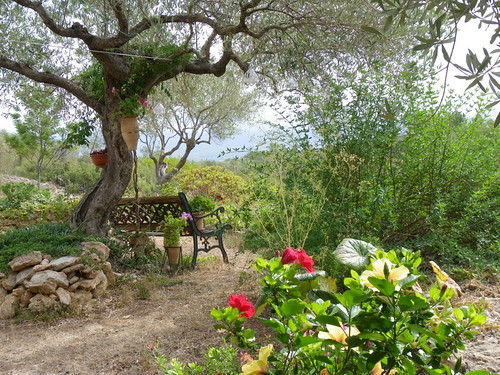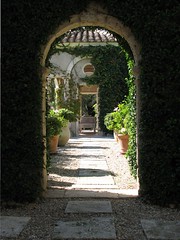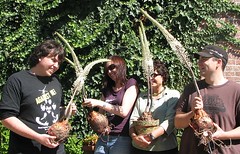Continued
from . . .Being familiar and comfortable with our local mediterranean climate is one thing, but understanding how it influences how we live and make gardens is another, perhaps something more subtle. Those who come to this region from elsewhere are often surprised at how different things are, but that feeling gradually fades and is not always considered later.

One of the first surprises is how ‘up-side-down’ the seasons are. When California was being marketed as the
best possible place to live back in the mid 1800s, they often featured rose bushes in full bloom in the middle of winter to appeal to those snow-bound during that season in the eastern US. While locally, it is not at all uncommon to find roses in flower in winter, they seldom put on the abundance found in spring. But there is
a lot of growing going on during our mild winter months.
Since we only get rainfall during late fall, winter, early spring, and winter temperatures rarely drop to freezing in many parts of mediterranean climate California, it makes sense that this is the growing season. Spring for us actually does start in what others would call winter. Many plants have been putting on growth since the first rains of fall and there is a veritable impatience to get blooming in January.
So, in contrast to many garden books and magazines, instead of bracing ourselves and our gardens for the onslaught of cold weather, we end up with a period in which active growth resumes with vigor. Wait a minute! Resumes? From what?
Those who have lived through more than one mediterranean summer learn to appreciate the coming of cooler, moister weather in the fall. Locally, we experience approximately
six months of zero rainfall. While we do not reach the high temperatures of some interior valleys and southern counties, towards the end of this dry season we’re ready to be done with the dust and the dried up vegetation. Many plants have gone into a state of suspended animation in order to get through. Even with supplemental water, plants know what’s going on and seldom perform as they might in summer rainfall regions.
This is our real dormant season – many plants have actually adapted a
summer dormant strategy, dying down to bulbs, corms, roots. Or they might avoid the dry period all together as an annual, completing growth and flowering before the onset of dry skies. Even evergreen plants slow their growth, make smaller leaves, or even lose some of them.
We can also go summer dormant – with climate adapted plants we needn’t be out in the hot summer sun watering our plants, helping them through the heat and dry which they are not evolved to withstand. We can relax. We can vacation. We can rid ourselves of the expectation that our gardens will be at their crowning peak during the difficult mediterranean summer.
I once had a client who complained that each summer when her kids were out of school and they traveled back east to visit the grandparents, there was no one who would consistently water her dahlias, florist’s
Gladiolus, her marigolds, her spike
Delphiniums. Upon her return, she inevitably found these plants doing poorly. Over the course of a year or two, I kept suggesting to her that she abandon these summer growing, summer thirsty flower for those more adapted to our climate patterns. That there were flowers that could be had in abundance in spring and even in winter and fall – all times in which she was home to enjoy her garden. Eventually she started to understand and followed my advice. Now she is very happy with her garden and, guilt free, leaves it to fend for itself during the summer while she is gone.






 One of the first surprises is how ‘up-side-down’ the seasons are. When California was being marketed as the
One of the first surprises is how ‘up-side-down’ the seasons are. When California was being marketed as the 














